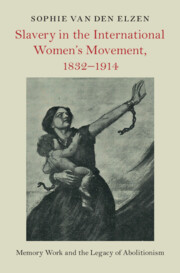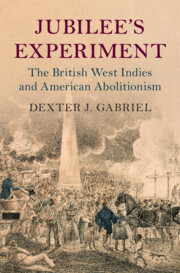Refine search
Actions for selected content:
46 results
Chapter 9 - Whiteness and the Slave Narrative
- from Part II - Whiteness in the American Literary Imagination
-
-
- Book:
- Whiteness and American Literature
- Published online:
- 19 June 2025
- Print publication:
- 03 July 2025, pp 135-147
-
- Chapter
- Export citation
Introduction
-
- Book:
- Slavery in the International Women's Movement, 1832–1914
- Published online:
- 19 May 2025
- Print publication:
- 05 June 2025, pp 1-29
-
- Chapter
-
- You have access
- Open access
- HTML
- Export citation
Concluding Remarks
-
- Book:
- Slavery in the International Women's Movement, 1832–1914
- Published online:
- 19 May 2025
- Print publication:
- 05 June 2025, pp 217-226
-
- Chapter
-
- You have access
- Open access
- HTML
- Export citation

Slavery in the International Women's Movement, 1832–1914
- Memory Work and the Legacy of Abolitionism
-
- Published online:
- 19 May 2025
- Print publication:
- 05 June 2025
-
- Book
-
- You have access
- Open access
- Export citation
21 - The Papacy and Slavery in Early Modern Europe, 1500–1800
- from Part IV - Theopolitics and Religious Diplomacy
-
-
- Book:
- The Cambridge History of the Papacy
- Published online:
- 28 February 2025
- Print publication:
- 20 March 2025, pp 544-569
-
- Chapter
- Export citation
1 - Introduction
-
- Book:
- Inquiring into Empire
- Published online:
- 18 March 2025
- Print publication:
- 27 February 2025, pp 1-30
-
- Chapter
- Export citation
2 - The State of Things
- from Part I - Constructive Conservatism in Empire
-
- Book:
- Inquiring into Empire
- Published online:
- 18 March 2025
- Print publication:
- 27 February 2025, pp 33-53
-
- Chapter
- Export citation
6 - Liberated Africans
- from Part II - The Problem of Unfreedom
-
- Book:
- Inquiring into Empire
- Published online:
- 18 March 2025
- Print publication:
- 27 February 2025, pp 141-171
-
- Chapter
- Export citation
8 - Slave Traders
- from Part II - The Problem of Unfreedom
-
- Book:
- Inquiring into Empire
- Published online:
- 18 March 2025
- Print publication:
- 27 February 2025, pp 198-222
-
- Chapter
- Export citation
6 - Antislavery in the Age of Rights
- from Part I - A Revolution in Rights?
-
-
- Book:
- The Cambridge History of Rights
- Published online:
- 22 January 2025
- Print publication:
- 28 November 2024, pp 140-159
-
- Chapter
- Export citation
3 - Making the Case for Collective Freedom
-
- Book:
- From Colonial Cuba to Madrid
- Published online:
- 14 November 2024
- Print publication:
- 21 November 2024, pp 105-146
-
- Chapter
- Export citation
16 - The Constitution at War with Itself
- from Part III - American Constitutionalism and Constitutional Identity
-
-
- Book:
- Deciphering the Genome of Constitutionalism
- Published online:
- 14 March 2024
- Print publication:
- 21 March 2024, pp 204-215
-
- Chapter
- Export citation
1 - The Politics of Slavery, Race, Nation, and Prison Building
-
- Book:
- Policing Freedom
- Published online:
- 03 August 2023
- Print publication:
- 17 August 2023, pp 48-105
-
- Chapter
- Export citation
Antislavery, “Native Labour,” and the Turn to Indenture in British Colonial Natal, 1842–1860
-
- Journal:
- Comparative Studies in Society and History / Volume 65 / Issue 3 / July 2023
- Published online by Cambridge University Press:
- 19 April 2023, pp. 500-525
-
- Article
-
- You have access
- Open access
- HTML
- Export citation
1 - The Anxieties of Emancipation
-
- Book:
- Jubilee's Experiment
- Published online:
- 30 March 2023
- Print publication:
- 06 April 2023, pp 16-39
-
- Chapter
- Export citation
2 - Fears of British Emancipation in America
-
- Book:
- Jubilee's Experiment
- Published online:
- 30 March 2023
- Print publication:
- 06 April 2023, pp 40-84
-
- Chapter
- Export citation
5 - The Experiment and Its Challenges
-
- Book:
- Jubilee's Experiment
- Published online:
- 30 March 2023
- Print publication:
- 06 April 2023, pp 164-194
-
- Chapter
- Export citation
Introduction
-
- Book:
- Jubilee's Experiment
- Published online:
- 30 March 2023
- Print publication:
- 06 April 2023, pp 1-15
-
- Chapter
- Export citation
3 - The Benefits of Free Labor
-
- Book:
- Jubilee's Experiment
- Published online:
- 30 March 2023
- Print publication:
- 06 April 2023, pp 85-124
-
- Chapter
- Export citation

Jubilee's Experiment
- The British West Indies and American Abolitionism
-
- Published online:
- 30 March 2023
- Print publication:
- 06 April 2023
